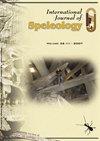考蒙洞穴和采石场系统(法国北部)的气候监测显示碳酸盐沉积接近氧同位素平衡条件
IF 1.3
4区 地球科学
Q3 GEOSCIENCES, MULTIDISCIPLINARY
引用次数: 0
摘要
对在接近同位素平衡条件下形成的现代洞穴沉积物进行研究,可能有助于厘清影响氧同位素系统的过程以及石笋作为过去水文或热变化档案的适宜性。我们利用洞穴监测评估了动力学同位素分馏的影响,并评估了位于法国西北部诺曼底的考蒙洞穴和采石场系统中现代洞穴碳酸盐形成的条件。在20个月的时间里,我们在考蒙洞穴和采石场系统内的三个不同站点,每隔2-4周采集一次气候数据、滴水和现代碳酸盐样本。我们发现考蒙洞穴和采石场系统较深地段的温度高度稳定(10.4 ± 0.3°C - 11.3 ± 0.1°C)。δ18Odrip的时间动态表明,考蒙的滴水成分反映了降水的原始信号(虽然很微弱),而不是季节性到年际性洞穴气温对同位素分馏的影响。监测结果表明,现代碳酸盐的δ13C受到夏季碳酸盐降水的影响,因为夏季的蒸腾作用会使有效渗透降到最低。通过比较滴水和玻璃板上沉淀的现代方解石(每两到四周收集一次)的δ18O,发现现代方解石的形成接近氧同位素平衡。对沉积在方解石形玻璃烧瓶上 20 个月的现代碳酸盐进行的亨迪测试证实了这一发现,因为δ13C 既不随与顶点的距离增加而增加,δ13C 和 δ18O 也不呈正相关。我们的结论是,岩浆中的δ13C 信号反映了夏季(以及更长期的)前期碳酸盐降水对有效渗透动力学的响应,而δ18O 信号很可能反映了洞穴上方降水成分的年度至多年变化。本文章由计算机程序翻译,如有差异,请以英文原文为准。
Climate monitoring in the Caumont cave and quarry system (northern France) reveal near oxygen isotopic equilibrium conditions for carbonate deposition
The study of modern cave deposits forming under near isotopic equilibrium conditions can potentially help disentangle the processes influencing the oxygen isotope system and suitability of stalagmites as archives of past hydrological or thermal changes. We used cave monitoring to evaluate the impact of kinetic isotope fractionation and assess the conditions under which modern cave carbonates form in the Caumont cave and quarry system, located in Normandy, northwest France. Over 20 months, we collected climatological data, dripwater, and modern carbonate samples at 2–4-week intervals at three different stations inside the Caumont cave and quarry system. We find highly stable (10.4 ± 0.3°C – 11.3 ± 0.1°C) temperature in the deeper sections of the Caumont cave and quarry system. The temporal dynamics of δ18Odrip indicates that the drip water composition in Caumont reflects the original (though subdued) signal of precipitation, rather than the impact the seasonal to interannual cave air temperature has on isotopic fractionation. The monitoring reveals that δ13C of modern carbonate is influenced by prior carbonate precipitation that occurs during the summer season when evapotranspiration can minimize effective infiltration. Comparison of δ18O from dripwater and modern calcite, precipitated on glass plates and collected every two to four weeks, reveals that modern calcite forms near oxygen isotope equilibrium. A Hendy test on modern carbonate deposited on a stalagmite-shaped glass flask over 20 months confirms this finding because neither does δ13C increase with distance from the apex, nor are δ13C and δ18O positively correlated. We conclude that the δ13C signal in speleothems reflect summer (and longer-term) prior carbonate precipitation in response to effective infiltration dynamics, and that the δ18O signal likely reflects annual to multi-annual changes in the composition of precipitation above the cave.
求助全文
通过发布文献求助,成功后即可免费获取论文全文。
去求助
来源期刊

International Journal of Speleology
地学-地球科学综合
CiteScore
3.10
自引率
23.10%
发文量
12
审稿时长
>12 weeks
期刊介绍:
The International Journal of Speleology has the aim to get cave and karst science known to an increasing number of scientists and scholars. The journal therefore offers the opportunity to all scientists working in and on karst to publish their original research articles or their review papers in an open access, high quality peer reviewed scientific journal at no cost. The journal offers the authors online first, open access, a free PDF of their article, and a wide range of abstracting and indexing services.
 求助内容:
求助内容: 应助结果提醒方式:
应助结果提醒方式:


